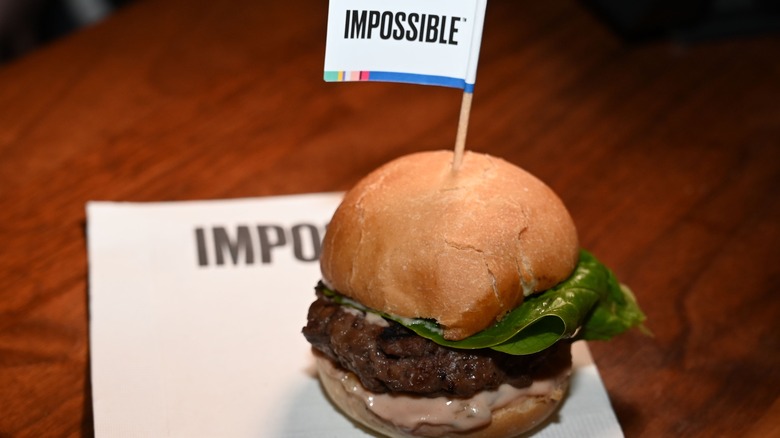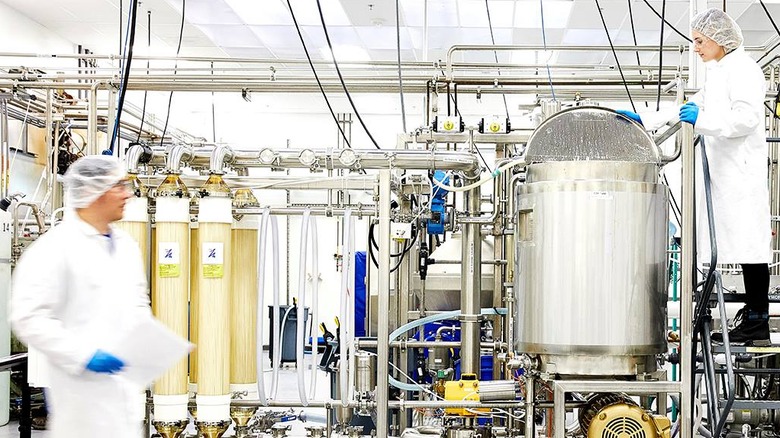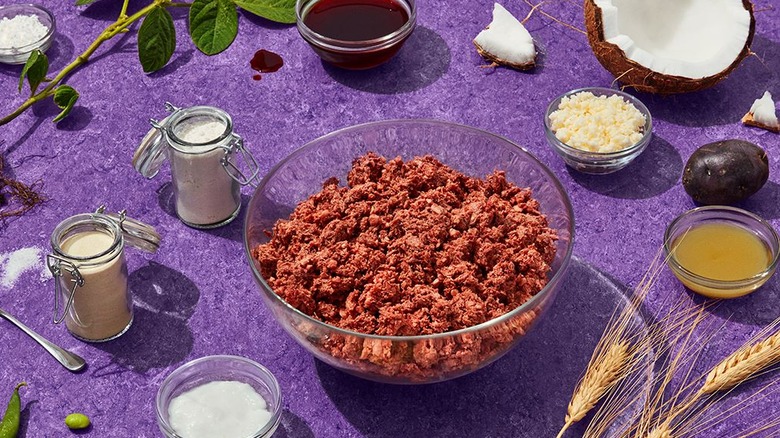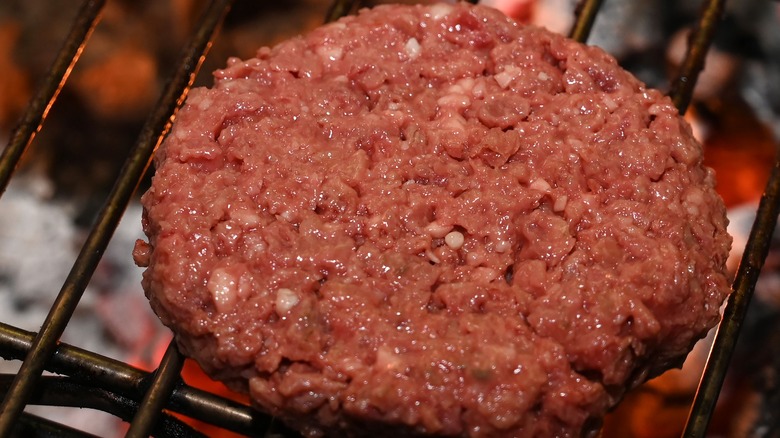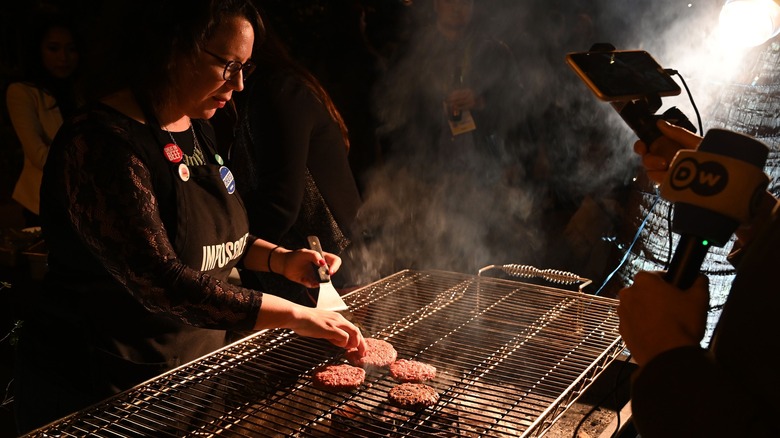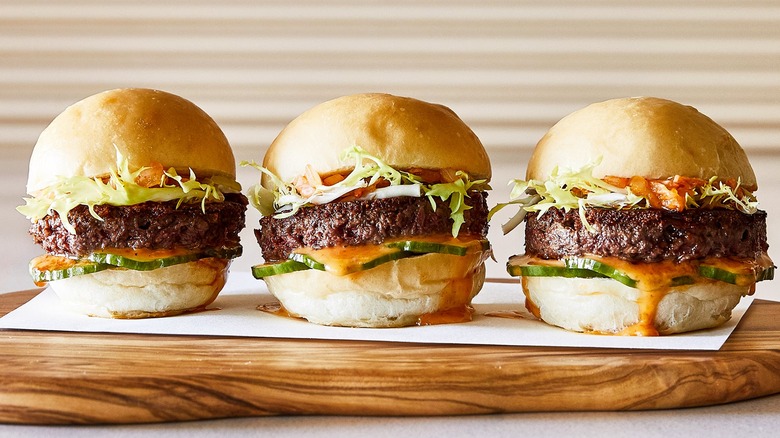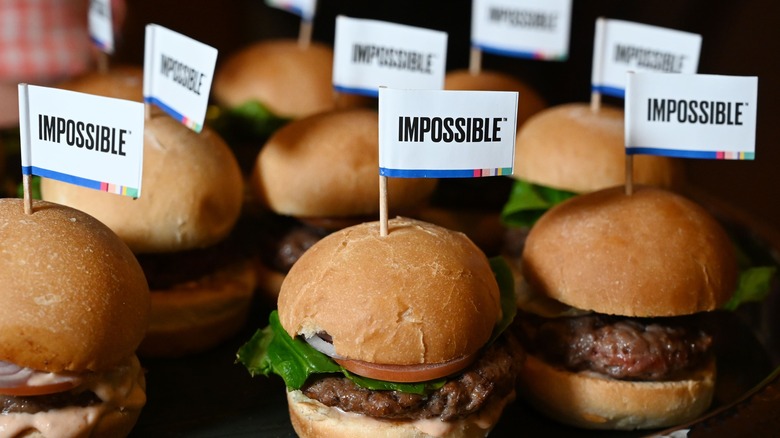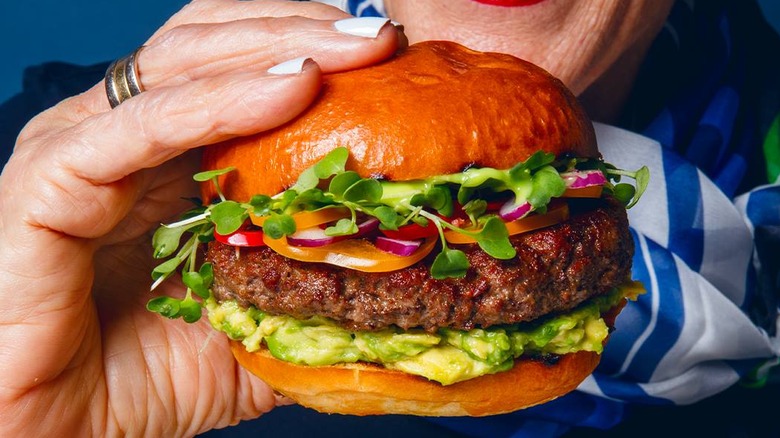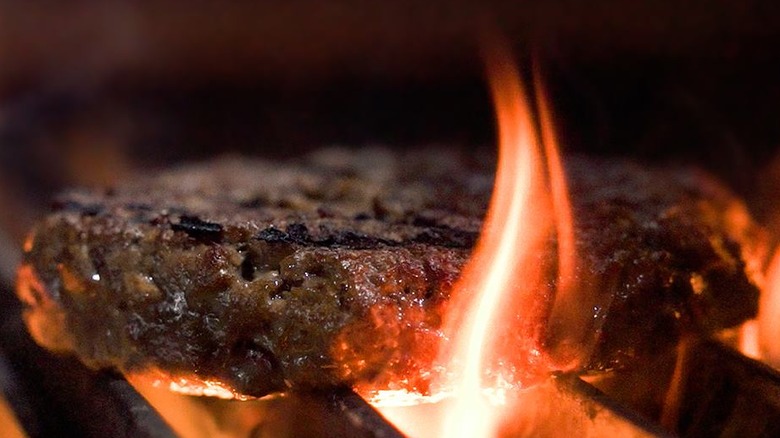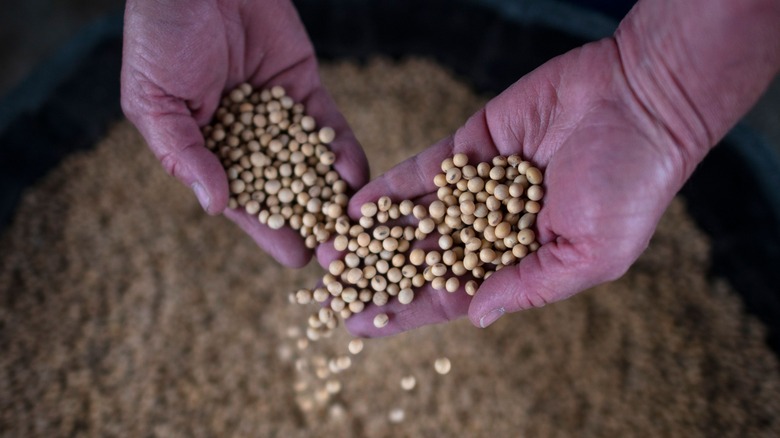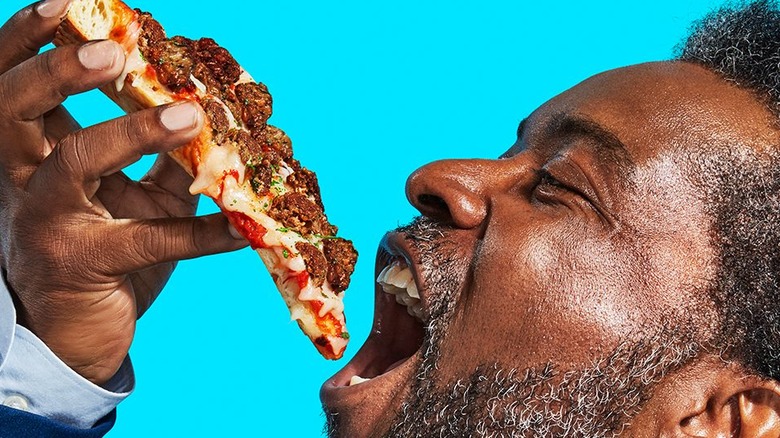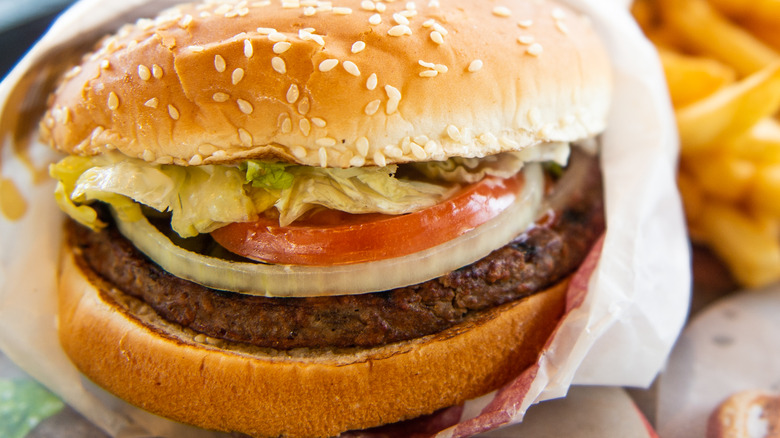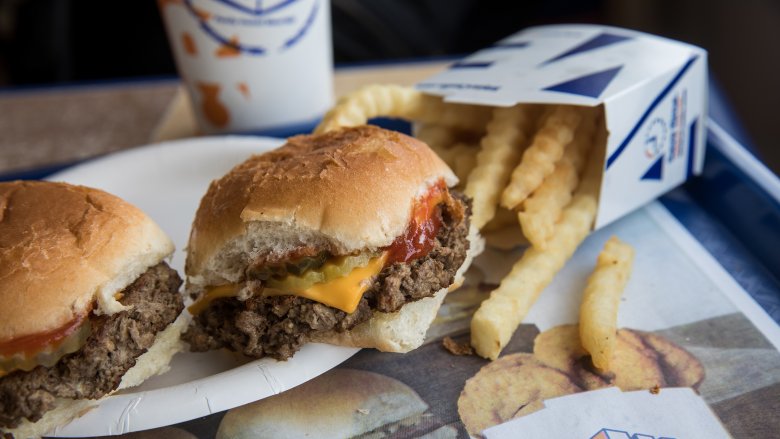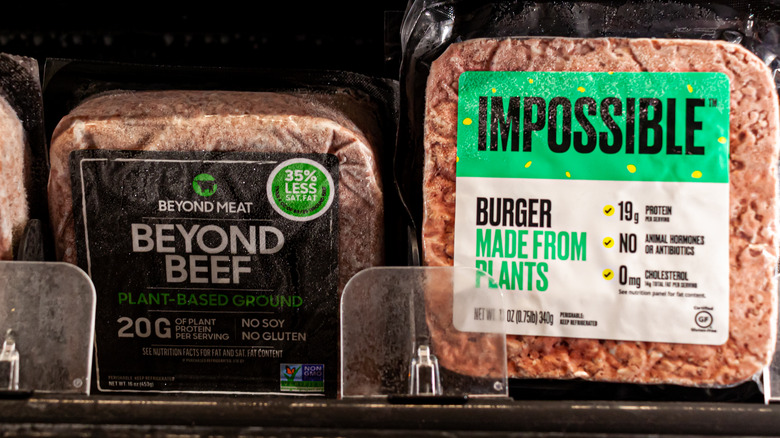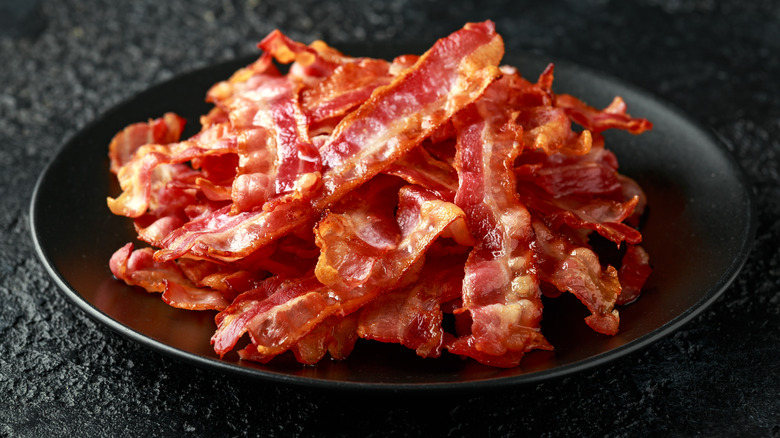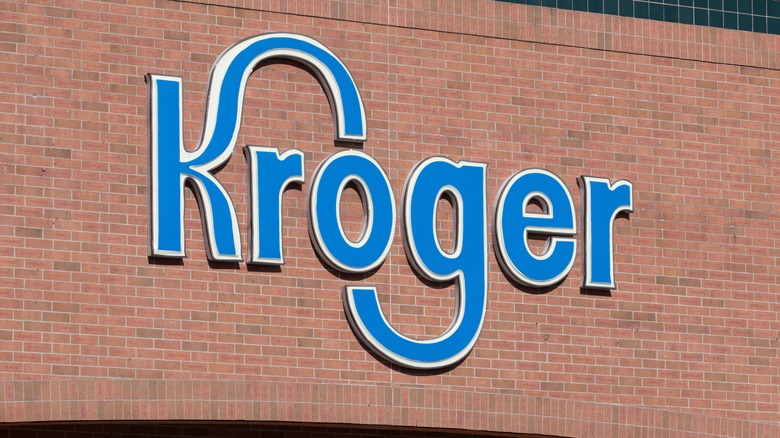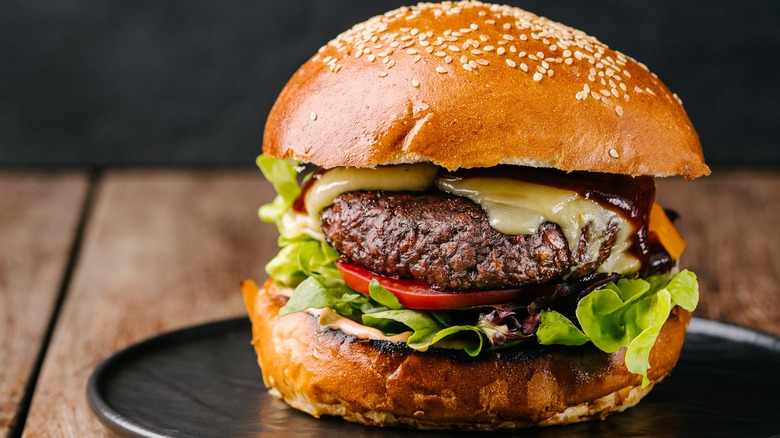The Untold Truth Of Impossible Foods
It might seem like the vegetarian and vegan movements have been gaining traction in recent years, but a Gallup poll from 2018 suggests differently. They found that only about 5% of Americans identify as vegetarian and 3% as vegan. That means the numbers of vegetarians have remained fairly consistent since 2012, and vegans have gained only a single percentage point.
But at the same time, sales of plant-based foods are on the rise, and that's implying people are open to substituting more vegetarian products without giving up on meat completely. That's likely why Impossible Foods has been steadily rising in prominence and popularity — among vegans and non-vegans alike — years after entering the market.
According to Time, Impossible Foods founder Dr. Patrick Brown has been experimenting with the idea since 2011. There have been a few different versions of the Impossible Burger since then, but given that they went international in 2018 (first heading to Hong Kong) and more and more fast food chains are adding these plant-based burgers to their menu, it's safe to say that they're a big hit. But what's the real story behind these faux beef burgers?
The team that made it happen
Impossible Foods wasn't founded by a chef or a revolutionary foodie, it was founded by a biochemist named Patrick Brown. He was working at Stanford University before he decided to start his company, and according to Nature, he didn't recruit chefs or foodies, either. He assembled a team of scientists of all sorts, who took a different approach to building the perfect veggie burger: They were engineering their burgers starting from the molecular level.
Brown told Time that they started with a question that was a little bit different from the norm. Instead of telling everyone why they needed to become vegetarian, they wanted to make a burger that just tasted better than a beef burger, and let people make their own choices. Brilliant, right?
So, they started with the things that make a burger delicious: texture, flavor, that sizzle when it's cooking on the grill. They wanted to find a way to recreate that with plant-based materials, and decided to do it with some scientific research into what makes beef burgers so good. The Impossible Foods team introduced themselves on Medium, and you'll find a biochemist with specialties in yeast genetics, a nutritionist, a small molecule chemist, a specialist in biological macromolecules... you get the idea. They're scientists rather than chefs, and they're engineering the perfect burger. Or, at least trying to.
The molecule that makes all the difference
Founder Patrick Brown says (via Medium) that they spent around six years studying meat on a molecular level to figure out how it "works," and how it all comes together to create something humans have been craving since we discovered hunting and fire. They found that there's one single molecule that's responsible for making meat taste so gosh darn good, and it's called heme.
And you're full of it right now — in fact, Brown says that in your body, you have the same amount of heme as you'd find in about 300 Impossible Burgers. Heme is a protein in hemoglobin, which is the stuff that carries oxygen through your bloodstream. It also helps in the process of turning calories into energy, and that means there's a lot of it in animal tissues. When those tissues are turned into food, it's heme that gives meat that distinctive flavor you can only describe as "meaty." You know the one.
Heme is present in plants, too, and there are all different kinds. They tested different types of plant-based heme until they found one that was very, very similar to animal-based heme, and settled on a protein extracted from the roots of legumes. Then, it was just finding a way to extract heme from plants, put it into their veggie burger, and presto! A meaty-tasting veggie burger!
The science behind the burger
Let's face it, most veggie burgers are super disappointing. They just don't have that same firm texture that a beef burger does, and they definitely don't have that same meaty taste. So, where does this heme come in and how do we get a veggie version of it?
Wired took a look at the science behind the heme, and it's complicated. Basically, soy roots contain a version of heme that has a similar molecular structure to the heme that's in animal tissue. Soy doesn't have nearly as much of it, though, so the scientific geniuses at Impossible Foods found a way to take the genetic codes from soy-based heme and insert it into a variety of yeast. They then feed the yeast to get it to multiply, and voila: heme on a grand scale, without the environmental impacts of raising fields and fields of either soy or cows.
That's only half the story, though. In order to get the rest of the puzzle pieces, they cooked real beef and exposed it to something called a gas chromatography mass spectrometry system. That isolated each and every molecule and compound present that created the smells of that cooking beef, and gave them the structure of the burger they needed to put the heme into to make sure the Impossible Burger also had that "meaty" aroma.
The debates about its safety aren't over
When it comes to food that comes out of a lab, Time asked Brown about just what kind of hurdles they're facing and whether or not the widespread resistance to engineered food is a problem. Brown pointed out that throughout human history, people have had to discover what's good to eat, what's bad, and that's pretty much what they're doing now — just in a lab. But there have been some major debates about whether or not Impossible Burgers are safe.
Bloomberg reported that the FDA has spent years going over the materials supplied by Impossible Foods, and in 2018 they reaffirmed their findings that the cooked burger is GRAS, or Generally Recognized as Safe. But that wasn't even the end of it. Since heme lends a red color to the burger, they were now required to formally register it as a color additive, adding just one more layer to the approval process. And that's all a big deal, as it has to be approved before raw burgers can hit grocery store shelves.
But, is it safe? Impossible Foods, the FDA, and an expert panel have produced a 1,000-page petition exploring everything from potential allergens to the safety of individual proteins and everyone's agreed that yes, it's safe. Still, registering heme as a color additive may open the product up to more questions, more tests, and more opposition.
What was the goal behind the project?
When Time interviewed Patrick Brown about the project, they asked him if he was building a business or trying to save the world, and the answer? "Well, it's both."
The first driving force behind the company was to change just how many animals we need to raise solely to put into the food chain. The impact the meat and dairy industries have on the environment is bordering on catastrophic, responsible for a huge amount of greenhouse gases, taking up an unthinkable amount of land, and causing the extinction of wildlife by pushing them out of their native habitats. The goal of Impossible Foods was to help change that, and along the way, they figured out that if they can get the company to take off, they can do much, much more.
"If Impossible Foods is successful, we solve the world's biggest environmental problem, solve food security problems, and even reduce conflicts, most of which start over land and water... when we've achieved sufficient scale, we should be able to produce meats that are not only more delicious but more affordable. This will have a huge impact, particularly in places where protein, malnutrition, and iron deficiencies are common." It might seem like those are unbelievably lofty goals, but Impossible Foods managed to get the backing of financiers like Bill Gates, the Open Philanthropy Project, Google Ventures, and investment firms in Shanghai and Hong Kong (via Food Business News).
How sustainable is it, really?
So, Impossible Foods has the goal of creating ultra-sustainable, environmentally friendly meat alternatives. How are they doing?
They hired Quantis — a firm that studies corporations and organizations to determine their environmental sustainability — to take a look at their environmental impact compared to beef production. First, we'll share this metric: beef accounts for about 3% of our caloric intake, but it's responsible for about half of all agricultural greenhouse gases and nearly half of the world's land use. That's pretty insane.
In comparison, they found that per kilogram of ready-to-ship Impossible Burger, this new meat alternative used 87% less water, 96% less land, produced 89% less greenhouse gases, and resulted in 92% less water pollutants.
And there's a lot of little things hidden in there. There are no manure emissions, there's a major reduction in energy usage (which mainly comes from slaughterhouses when you're talking about the meat industry), and you're not only looking at getting rid of the environmental impacts of the cattle themselves, but from growing the crops you need to feed them with. So yes — it's super sustainable, and that's good news.
The good news, nutritionally speaking
The Impossible Burger might be good for the planet, but is it good for you? According to Healthline, there's actually a lot of good stuff in that faux-beef burger.
The basic ingredients include soy protein, sunflower oil, yeast extract, potato protein, and a whole bunch of vitamins and nutrients. And strangely, when you look at the nutritional information charts, Impossible Burgers look pretty similar to a 90% lean beef burger. Both patties contain 240 calories, around the same amount of fat (14 grams for the Impossible Burger, 13 for the beef burger), and have roughly the same percentage of nutrients like zinc and niacin.
Impossible Burgers are lower in protein but higher in fiber, and they're also higher in vital nutrients like vitamin B12, thiamine, and iron. Those are all important for a few reasons, particularly the iron. It's not just regular iron, it's heme iron — and heme iron is more readily absorbed by the body. Plus, for those vegetarians and vegans that opt to add the Impossible Burger into their diet, they're getting an extra dose of vitamins that are missing from many vegetarian diets. Still, it's important to note that many of those extra nutrients are added to the impossible, whereas they're naturally occuring in beef — just in lower quantities.
The bad news, nutritionally speaking
Healthline says there's still the potential for down sides to the Impossible Burger, and part of those possible negatives simply comes from the fact that it — and plant-based heme in particular — hasn't really been studied in-depth, and long-term effects of it are still unknown.
There's also been concerns over potential allergic reactions. The Impossible Burger is gluten-free, but allergies to soy is still one of the eight most common food allergies found in both children and adults.
Experts also say that there are healthier alternatives when it comes to veggie burgers, and point out that the Impossible Burger is high in sodium and contains added preservatives, fillers, and flavorings that are all designed to help mimic the taste and texture of real beef. Should you be concerned? The FDA says no, but if you or anyone in your family has a sensitivity to soy, you should absolutely avoid this one.
What about all the horror stories we've heard about soy?
Check out the ingredient list of the Impossible Burger and you'll find that the second ingredient (after water) is soy protein concentrate. Aside from the potential for allergens (which is pretty much a dealbreaker if you have them), there's been a ton of debate over just how healthy or unhealthy soy can be. So what's the current science say?
Men's Health looked into the issue, and the experts they talked to suggested that many of the claims that soy does all sorts of horrible things like disrupting hormones have been vastly blown out of proportion by the media. According to Healthline, studies have linked soy to lower cholesterol, improved fertility, and a reduction in the symptoms of menopause.
When it comes to the rumored bad stuff — negatively impacting thyroid function, hormone levels, and raising the risk of certain types of cancers — they stress that studies have been inconclusive, and there's no real, concrete links to any of these negative side effects.
Is it really that good?
So, here's the elephant in the room: does the Impossible Burger live up to the hype, and does it really taste like beef? Apparently, that depends.
CNET reporter and decade-long vegetarian Joan E. Solsman said the plant-based meat was so much like real meat that it grossed her out to the point where she just couldn't bring herself to eat more than a few bites, saying, "That's also a compliment. I think."
Digital Trends called the recently redesigned Impossible Burger "the most impressive thing on display at CES 2019," and that's a huge compliment, too. They said the company had finally gotten everything right, from the taste and texture to the smell — all the key ingredients.
New York's Grub Street was slightly less thrilled... but only slightly. They said that not only did the burger look like the real thing, but it didn't have any of that crumbly texture so many veggie burgers have. They stressed, though, that while most meat-eaters would still definitely be able to tell the difference between the two in a blind taste test, they would still highly recommend giving one a try.
Versions 1.0 vs. 2.0
The version that was rolled out in 2019 was actually the second official recipe: the Impossible Burger 2.0. New York's Grub Street tasted both the 2.0 and the original Impossible Burger, and said there was a definite, all-around improvement and the new version was definitely more meaty — in spite of the fact that it didn't seem to "bleed" as much as the first version. So, what's the actual difference?
It's all down to that heme, says Popular Science. In order to be used, heme has to be bound to a protein. The original Impossible Burger used wheat protein, but there were a few problems. The biggest? Texture and gluten.
The original Impossible Burger couldn't be shaped into serving sizes like meatballs without crumbling. Meat doesn't crumble, so that put a bit of a hitch in any plans to use Impossible meat for anything super creative in the kitchen. The wheat-based protein also meant that it wasn't gluten free, and both of those problems were solved when they overhauled the recipe to use soy protein.
So, will there be a Version 3.0? Brown says it's highly likely, and one of the big changes they're hoping to bring to the table is making it even more affordable.
Where you can try one
White Castle was among the first to announce they were taking their Impossible Burger sliders nationwide. That big reveal came in September 2018 (via CNBC), after an initial trial run in 140 locations. CEO Lisa Ingram said, in part, "Sales easily exceeded our expectations."
And in April 2019, two big fast food chains announced they were going to be adding Impossible burgers to their menu, too. The Impossible Whopper was going to slowly be added to Burger King's Whopper family location by location, and by the end of the calendar year, they were planning on having them available at every BK nationwide (via Vox). Whoppers aren't your thing? Qdoba announced they were going to be rolling out Impossible meat proteins slowly. After a successful test run in Michigan, the Mexican restaurant announced that Denver, Los Angeles, and Brooklyn were going to be the next markets to get it, and that all other stores would get them soon after (via QSR Magazine). Since then, the plant-based meat has become a staple ingredient in many of Qdoba's menu offerings (via PR News Wire).
And don't worry, Impossible Foods isn't going to stop there. A quick glance at their Facebook page shows that there's a ton of restaurants getting on board with the movement and creating their own signature Impossible Burgers. Is it a fad, or are they all here to stay? Only time will tell.
What's the difference between Impossible Foods and Beyond Meat?
Impossible Meat is not the only company responding to the growing consumer desire for environmentally sustainable but realistic meat substitutes. It's not even the first company to do so; per Thrillist, its closest competitor, Beyond Meat, was founded in 2009, while Impossible Foods launched in 2011. Both companies offer burgers and sausages intended to be compelling enough to entice curious carnivores, and both have attracted celebrity investors, including Kyrie Irving, Bill Gates, and Jessica Chastain.
But there are also significant differences between the two companies and their products. First, their base ingredients are different: While Impossible Foods' ground beef substitute is based on soy and potato protein and gets its meat-like red color from a proprietary plant-based preparation of heme (the iron ion that occurs in blood and contributes a characteristic color and flavor to red meat), Beyond Meat's primary base is a combination of pea, mung bean, and rice protein, colored with beet juice extract. These differences are also behind their difference in taste: According to Thrillist, Impossible Foods' meat patties taste more like real beef than those offered by Beyond Meat– which Thrillist still found tasty in their own right. In addition, the companies' choices of product lines also differ; besides its ground beef substitute, Beyond Meat focuses on prepared "meats" such as brats, jerky, and meatballs, while Impossible Foods focuses more heavily on basics, such as Impossible ground beef and pork.
Impossible Foods bacon is on the way
For many omnivores, the siren song of bacon is a major factor stopping them from biting the bullet and going completely meatless. Sure, tofu, tempeh, and other meat substitutes can be delicious and are less of a strain on the environment, but what could possibly replace the smoky, fatty, crunchy decadence of bacon? For many, the idea of giving it up for life is an unthinkable horror. It's likely these conflicted flexitarians were the intended audience for Burger King's Impossible Southwest Bacon Whopper, an unlikely preparation featuring a vegan Impossible Burger along with regular cheese and bacon.
But just as Impossible Foods initially strove to create a vegan burger good enough to win over omnivores (via Time), it's now taking on the challenge of creating vegan bacon tasty enough to convince them to go meatless. According to CNET, this project was revealed at the 2020 unveiling of Impossible Pork at CES Las Vegas, when an audience member asked Impossible Foods CEO Pat Brown if they'd considered making everyone's favorite pork preparation, now that they'd mastered Impossible Pork. "Of course we are, and in fact, we've already played around with it," he replied. But if you're already craving Impossible Bacon, you'll have to be patient. "We're not going to release a bacon product until we feel like anyone who is the most hardcore bacon worshipper thinks it's awesomely delicious," Brown said. "But we're definitely on track."
Impossible Foods teamed up with Kroger in 2022
As Impossible Foods grows as a company, its products are becoming not only easier to find, but also easier to afford. According to Food Manufacturing, its steady growth has allowed it to take advantage of new economies of scale, which has led the company to pass its savings on to consumers. But Impossible Foods is also exploring other ways to make its products more affordable to engage new customers.
A major step towards this goal is Impossible Food's recent partnership with the grocery store chain Kroger (via CNBC). Under this deal, Kroger will not only carry Impossible Food's branded products, but also collaborate with the company on the creation of its own line of private-label meat alternatives. This matters for a couple of reasons: For one, it shows the company is seriously committed to expanding its reach, even if it means lower profit margins. (Per CNBC, the announcement caused stock in Impossible Foods competitor Beyond Meat to plummet.) Second, it brings Impossible Foods closer to its goal of making the price point of its products competitive with meat, which the company hopes will encourage cost-conscious consumers to give them a chance.
Bill Gates and Serena Williams both invested in Impossible Foods
From the beginning, Impossible Foods intentionally sought out high-profile boosters. According to The Business of Business, the company actively courted chefs, foodies, and celebrities from the time its first product, the Impossible Burger, launched in 2016. This strategy succeeded, resulting in significant investments from A-listers including Jay-Z, Serena Williams, and Bill Gates.
For both Williams and Gates, their investments in Impossible Foods were part of larger, mission-driven investment strategies. Recently retired from professional tennis, Williams told Vogue that she is planning to shift her focus more fully to her venture-capital firm, Serena Ventures, which invests in woman-owned companies and those focused on sustainability — including Impossible Foods. The fact that Williams has been a vegan since 2012 gives this investment extra personal resonance. Gates, too, has been investing with an eye towards sustainability and, per Green Queen, sees meat alternatives as an important tool for combatting climate change. He has invested heavily in a number of alternative protein businesses, with his repeated investments in Impossible Foods estimated to be around $50 million.
Many have enjoyed Impossible Foods products at Disney parks
The Happiest Place on Earth has not always been the cheeriest place for vegans. As VegNews observed, "A vegan at a Disneyland (or the neighboring California Adventure and Downtown Disney) can turn Grumpy in the grips of hunger pangs while being surrounded by others eagerly indulging in Mickey Mouse-shaped treats." Fortunately, this has started to change: Disney got the message and launched an initiative in 2019 to bring more vegan options to its parks. And as part of this initiative, it partnered with Impossible Foods to highlight their products in its dishes, including an Impossible Burger topped with vegan chili and spaghetti with Impossible Meatballs.
For Impossible Foods, this partnership is not merely a way to get more its products to grateful vegans, many of whom are already familiar with the company's offerings. It's also part of the company's larger strategy to get its products in front of new audiences while winning over carnivores. And offering their products in a dining environment known for fun — and one in which would-be diners might be in more of a mood for adventure than usual — could be a smart tactic for winning new fans.
Where you can try Impossible Foods
When Impossible Foods first launched the Impossible Burger in 2016, it aimed for buzz and social cachet before shooting for widespread accessibility, according to The Business of Business. It first offered the burgers to high-end eateries such as David Chang's New York restaurant Momofuku Nishi and the critically acclaimed restaurant Jardinière in San Francisco. Only after these tastemakers gave it their seal of approval did they expand its distribution to chains including Applebee's, Cheesecake Factory, and Hard Rock Café, followed by larger fast-food outlets including White Castle, Little Caesar's Qdoba, Burger King, and Red Robin. More recently, Cracker Barrel announced it was adding Impossible Sausage as an option along with regular sausage on its menu, a move that was met by howls of outrage from some of the restaurant's carnivorous fans. (And these complaints were met in turn by rejoinders that other people's dietary preferences were none of their business).
Today, you don't have to go to a restaurant to enjoy Impossible Foods. In 2019, the company began selling its uncooked burgers in supermarkets, and demand and distribution have both grown. Their products are now available at Wegmans, Fairway, Ralphs, Wal-Mart, Vons, Safeway, and Albertsons, among other U.S. chains, as well as in Hong Kong, Macau, and Singapore. In short, if you want to try Impossible Foods, you won't have to look too hard — chances are, you'll find some just a short walk or drive away.
